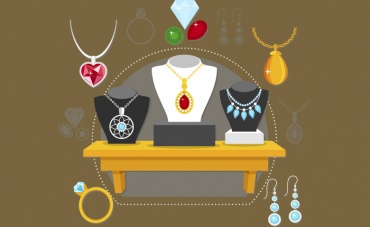Decorative Role of Gold as Jewelry All Along History

Gold has long been highly prized for its beauty and rarity and has been widely used in the production of jewelry and decorative arts. Gold has been a significant factor in the growth of artistic traditions all over the world, from the elaborate gold jewelry of ancient Egypt to the delicate filigree work of the Renaissance.
Gold was revered as a divine metal and connected to the sun god Ra in prehistoric Egypt. The pharaohs adorned themselves with ornate gold jewelry, including headdresses, bracelets, and necklaces with intricate designs. Rich people’s elaborate sarcophagi and other funerary items were also made out of gold.
Gold was still highly prized for its beauty and scarcity during the Middle Ages and the Renaissance. Thin gold wires were used by goldsmiths to create delicate patterns and designs in their intricate filigree work. Luxurious items like reliquaries, caskets, and chalices were also made from gold.
Palaces, churches, and other public structures were lavishly decorated with gold during the Baroque and Rococo eras. Architectural features like ceilings, moldings, and sculptures were decorated with gold leaf. Additionally, lavish decorative arts like gilt clocks, mirrors, and furniture were made with the use of gold.
Gold continued to play a significant role in the design of jewelry and decorative arts throughout the 19th and 20th centuries. Gold was embraced as a natural material and a form of art by the Art Nouveau movement, which first appeared in the late 19th century. Jewelers working in the Art Nouveau style produced highly stylized pieces with wavy lines and intricate designs that frequently used precious stones and enamel.
Gold remained a significant component of jewelry and decorative arts throughout the 20th century, especially during the Art Deco era. Often using gold as a background for diamonds and other precious stones, Art Deco designers favored geometric shapes and vivid colors.
Gold is still a preferred material for making jewelry and decorative items today. Due to its strength and malleability, it can be easily shaped to create intricate designs, and due to its high cost and scarcity, it is a popular choice for high-end products. To make one-of-a-kind and expensive pieces, gold is frequently combined with other materials like diamonds, pearls, and colored gemstones.
Gold has long been a preferred material for interior design and architecture in addition to being used in jewelry and decorative arts. It is a strong and long-lasting material that can be used for domes, building facades, and other decorative elements because of its resistance to corrosion and oxidation.
The Dome of the Rock in Jerusalem is one prominent illustration of gold used in construction. The gold-leaf-covered dome, which was finished in 691 CE, dominates the city’s skyline. Similar to this, over 750 kg of gold are used to cover the Golden Temple in Amritsar, India, as a representation of the metal’s spiritual significance to Sikhs.
Gold is still a common material in interior design today, especially in opulent hotels, eateries, and private homes. Gold adds a touch of glitz and sophistication to any space, whether it be wall coverings, furniture, or faucets and fixtures that have been plated in gold.
Gold has uses that go beyond decoration, including in the fields of electronics and medicine. In addition to being used in electronics like computers and cell phones, gold is also used in cancer treatments and diagnostic tests.
The use of gold in jewelry and decorative arts has a long and rich history that spans thousands of years and encompasses a wide range of artistic traditions. Gold has been a significant part of culture from ancient Egypt to the Art Deco movement in the 20th century. Gold has also been essential to the advancement of medicine. Ailments like rheumatoid arthritis and tuberculosis have been treated with gold for many years. Even today, there are still many medical applications for gold, including the treatment of cancer and the diagnosis of illnesses using imaging agents based on gold.
Author: Pooyan Ghamari, Economist Visionary and Specialist in Gold and Banking
Comments are closed.